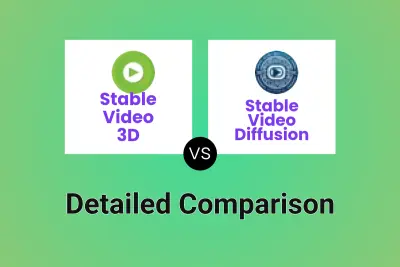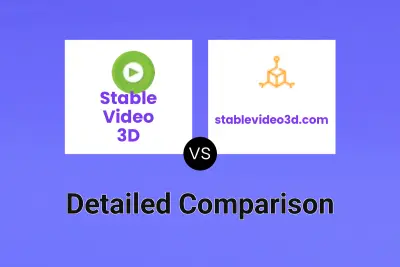 Stable Video 3D
VS
Stable Video 3D
VS
 Stable Video Diffusion
Stable Video Diffusion
Stable Video 3D
Stable Video 3D (SV3D) is an innovative generative model that revolutionizes 3D technology by enabling high-quality novel view synthesis and 3D generation from single images. Built upon Stable Video Diffusion technology, it delivers significantly improved quality and view-consistency compared to existing solutions.
The platform offers two distinct variants: SV3D_u for generating orbital videos from single images without camera conditioning, and SV3D_p for creating 3D videos along specified camera paths using either single images or orbital views. Both variants maintain exceptional quality while ensuring consistent object appearance across multiple viewpoints.
Stable Video Diffusion
Stable Video Diffusion represents a breakthrough in AI video generation technology, combining sophisticated image pre-training with extensive video dataset learning to create dynamic videos from static images. The system utilizes multi-view 3D priors and advanced fine-tuning techniques to ensure high-quality video output.
This innovative platform employs a comprehensive approach to video generation, incorporating text-to-video capabilities and specialized training on high-quality video data. It enables users to transform static content into fluid, motion-rich videos while maintaining visual consistency and quality throughout the generation process.
Pricing
Stable Video 3D Pricing
Stable Video 3D offers Freemium pricing .
Stable Video Diffusion Pricing
Stable Video Diffusion offers Free pricing .
Features
Stable Video 3D
- Novel View Generation: Creates realistic and consistent views from any angle
- 3D Mesh Generation: Produces high-quality 3D meshes directly from single images
- Disentangled Illumination: Reduces baked-in lighting issues for realistic results
- Multi-view Consistency: Enhanced 3D optimization from novel views
- Dual Variants: SV3D_u for orbital videos and SV3D_p for camera path-specific videos
Stable Video Diffusion
- Image-to-Video Conversion: Transform static images into dynamic video content
- Multi-View Generation: Create videos with rich visual perspectives using 3D priors
- Text-to-Video Support: Generate videos from textual descriptions
- Customizable Motion Control: Adjust motion intensity through motion bucket settings
- FPS Control: Customize frames per second for optimal video output
- User-Friendly Interface: Simple four-step process for video generation
Use Cases
Stable Video 3D Use Cases
- 3D Content Creation
- Product Visualization
- Virtual Reality Content
- Digital Asset Creation
- Object Modeling
- Virtual Photography
- Animation Production
Stable Video Diffusion Use Cases
- Creating creative advertisements
- Producing movie trailers
- Developing educational video content
- Generating dynamic game scenes
- Creating social media content
- Making product demonstrations
- Enhancing presentation visuals
FAQs
Stable Video 3D FAQs
-
Can I use SV3D for commercial purposes?
Yes, SV3D can be used for commercial purposes with a Stability AI Membership. -
What are the two variants of SV3D?
SV3D has two variants: SV3D_u which generates orbital videos from single images without camera conditioning, and SV3D_p which creates 3D videos along specified camera paths using either single images or orbital views.
Stable Video Diffusion FAQs
-
Why is Stable Video Diffusion significant?
It represents a major advancement in AI video generation technology, offering new possibilities for content creation across various sectors, including advertising, education, and entertainment. -
Is Stable Video Diffusion easy to use for beginners?
Yes, Stable Video Diffusion is designed with a user-friendly interface, making it accessible for beginners. With straightforward controls and intuitive navigation, users can start creating AI-generated videos with minimal learning curve. -
Is Stable Video Diffusion open source?
Stability AI has released the Stable Video Diffusion code on GitHub, fostering an environment of open-source collaboration and development. -
Is it possible for Stable Video Diffusion to create videos of extended length?
At present, the models are primarily fine-tuned to craft brief video segments, usually lasting about four seconds. Extending this to create more prolonged video content could be an area of emphasis in upcoming advancements.
Uptime Monitor
Uptime Monitor
Average Uptime
80.13%
Average Response Time
312.2 ms
Last 30 Days
Uptime Monitor
Average Uptime
68.44%
Average Response Time
107.93 ms
Last 30 Days
Stable Video 3D
Stable Video Diffusion
More Comparisons:
Didn't find tool you were looking for?

